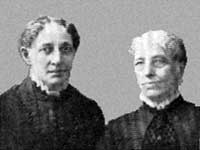 |
| Coconuts Cafe |
Location: 311 W. Madison Street, Baltimore, Maryland, USA
Opened: 1996?
Closed: 2009
To my knowledge, Coconuts Cafe is the only "Hawaian-style" lesbian bar that ever existed--at least outside Hawaii. Here's how it used to be advertised:
Hawaiian-style lesbian bar
During the day, Coconuts is a fun place to hang out, play pool, watch sports, eat off of its reasonably-priced menu, and stick around for Happy Hour. Once Happy Hour is over, the DJ's start spinning and the crowd hits the dance floor. Some nights there is live music, and the 2nd and 4th Sunday there are free swing dancing lessons.
The Coconuts Cafe was very well thought of in its day. It won the "Best Lesbian Bar" award from the Baltimore City Paper in both 1996 and 1999. Here's what they said about it back in 1996:
There’s a certain beauty to the idea of a former cop hangout, Kavanaugh’s, being reincarnated as a lesbian bar. Although some of the women who frequent Coconuts look as though they might have a uniform fetish—not necessarily a bad thing—there is a refreshing diversity to the Coconuts crowd. The drinks are cheap, the bartenders are cute, and the women tend to be fairly sassy. These are women out to par-tay. The kitchen is open until 1:30 a.m. and it serves surprisingly good bar food. The only quibble we may have is the uneven, somewhat lackluster quality of the music being played. We always assumed a DJ meant someone mixing vinyl, not turning on a CD player. And yes, men do pass through Coconuts’ doors and are welcomed.
And here's what they said in 1999:
And here's what they said in 1999:
This tropical-motif bar is usually filled with a preponderance of baby dykes, who can be quite cliquish. But the drinks are fairly cheap and Coconuts offers regular specials on everything from 25-cent chicken wings to free pool. Its kitchen serves tasty bar grub at reasonable prices, so you can fuel up before the heavy cruising starts. And there's a tiny dance floor where women can be found shimmying and checking out the action.
And then the good times came to an abrupt halt in March 2009:
(Baltimore, Maryland) Baltimore police have widened their search for a woman who shot and killed another woman and wounded two others after an altercation in one of the city’s oldest lesbian bars.
Sctario Tia Edwards, 25, and the suspect bumped on the dance floor of Coconuts Cafe early Saturday morning and an argument ensued.
The dispute continued outside the club when Edwards and another woman left. The suspect began beating the two women with a metal pipe and then pulled a gun, shooting Edwards multiple times.
At one point, Edwards attempted to run after being hit by the first shot, police said, but the suspect chased her down and shot her again several times. She died later in hospital.
Edward’s friend was hit in the hand by another shot, and a women on the street heading to the club was struck by stray gunfire. Both were treated in the hospital and released.
The suspect escaped but police said they have a good description. So far, though, there have been no arrests.
No night club for women can survive for long when it's associated with murder. Coconuts Cafe was no exception. Especially when even before the shooting, the surrounding neigborhood was regarded as a "bit scary." Even though by the end of March, Sharone Latrice Newton--who had a long history of criminal offenses--had been arrested and charged with first-degree murder (along with 17 other things). I'm unable to determine if Newton was ever convicted.
Coconuts closed shortly after the Edwards murder, with the Waterstone Bar and Grille opening at that location by the end of the year.












